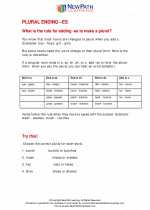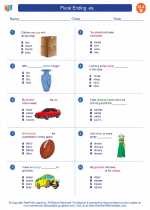Plural Ending -es
In English, we form the plural of most nouns by adding -s to the end of the word. However, there are some nouns that require the ending -es to form their plural. Understanding when to use -es instead of just -s is important for correct grammar and communication in English.
Rules for Adding -es
There are a few rules to keep in mind when adding -es to form the plural of a noun:
- If a noun ends in s, x, ch, sh, or z, add -es to form the plural.
- For nouns ending in consonant + y, change the y to i and add -es.
- For nouns ending in vowel + y, simply add -s to form the plural.
Examples
Let's look at some examples to understand how to apply the rules for adding -es:
Rule 1: Nouns ending in s, x, ch, sh, or z
- bus - buses
- box - boxes
- church - churches
- brush - brushes
- buzz - buzzes
Rule 2: Nouns ending in consonant + y
- baby - babies
- city - cities
- party - parties
Rule 3: Nouns ending in vowel + y
- key - keys
- day - days
- boy - boys
Study Guide
Here are some tips for studying and practicing the plural ending -es:
- Make flashcards with singular nouns on one side and their plural forms on the other side. Practice going through the flashcards to reinforce the spelling of plural nouns with -es.
- Use online quizzes and games to test your knowledge of plural nouns with -es. There are many interactive resources available to help you practice and improve your skills.
- Write sentences using plural nouns with -es to ensure that you understand how to use them in context. This will also help you remember the correct spelling and form of the plural nouns.
Remember, practice makes perfect, so keep practicing and applying the rules for plural ending -es to become more confident in using them correctly in your writing and speech.
[Plural Ending -es] Related Worksheets and Study Guides:
.◂English Language Arts Worksheets and Study Guides Second Grade. Plural Ending -es
Study Guide Plural Ending –es
Plural Ending –es  Worksheet/Answer key
Worksheet/Answer key Plural Ending -es
Plural Ending -es  Worksheet/Answer key
Worksheet/Answer key Plural Ending -es
Plural Ending -es  Worksheet/Answer key
Worksheet/Answer key Plural Ending -es
Plural Ending -es 

 Worksheet/Answer key
Worksheet/Answer key
 Worksheet/Answer key
Worksheet/Answer key
 Worksheet/Answer key
Worksheet/Answer key

The resources above cover the following skills:
Writing Standards: Foundational Skills
Spelling
Know and apply phonics and word analysis skills when encoding words.
Spell on-level, regular, single-syllable words that include:
Plurals and possessives (e.g., its, it's).